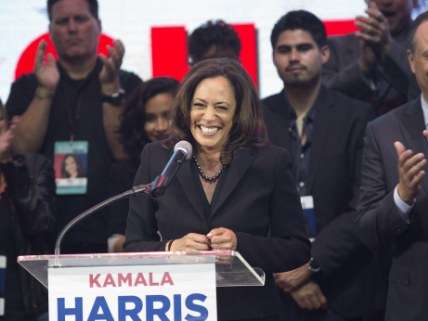More Californians Voted for Ballot Initiatives Than for a Senator
More than a million didn't bother, given the 'choice' of two Democrats.


California Attorney General Kamala Harris has easily defeated Rep. Loretta Sanchez to replace retiring Sen. Barbara Boxer. It wasn't even close: Harris is essentially getting two votes for every vote for Sanchez. She had the support of the establishment, and even President Barack Obama appeared in advertisements endorsing Harris.
Everybody mentioned above is a Democrat. There were no Republicans or Libertarians or Greens or anybody else listed as a Senate candidate for voters to consider. That's because Sanchez and Harris got the most votes in California's primary, and the state has shifted to a top-two election system for statewide and lawmaker races. Only the top-two candidates make it to the fall ballot.
Proponents of the top two system say it makes races more competitive and encourages candidates to appeal to a larger voter base. How did that work out here? Well, as can be seen above, the race was not remotely competitive. The Democratic establishment rallied behind the most powerful and connected of the two candidates and the other one was essentially left to rot.
But what about the voters? According to the latest figures from the Secretary of State's office, 8.9 million Californians cast votes for one of the candidates for president. Only 7.7 million people cast a vote for one of the senators. That's a gap of 1.2 million. That many people went through the effort to vote, but did not vote for a Senate candidate (full disclosure: I was one of them). If all those non-voters had gone for Sanchez she … still would have lost badly. But it would have been more competitive, anyway.
In fact, more people voted on most of the ballot initiatives than voted for the Senate race. 8.9 million people voted either for or against Proposition 64, the marijuana legalization initiative. More people voted on whether to ban plastic bags (8.5 million—unfortunately the ban passed) than the Senate race.
So what happens when we look at the 2010 election, when Boxer last faced a challenge (from former GOP presidential candidate Carly Fiorina)? We have to be careful with the numbers, first of all. While 100 percent of the precincts have reported in, there are still absentee and provisional ballots out there to be tabulated. These numbers are going to go up, significantly.
Still there's a noticeable difference, given that we're talking about a midterm election with no president bringing people in to vote. More than 9.8 million people cast votes in the Senate race in 2010. That's similar to the number of folks who voted in the governor's race. Similarly several ballot initiatives surpassed the 9 million vote threshold.
With so many votes still to count, the overall voter turnout may match or exceed 2010's participation. But the point here is to note the massive gap between the Senate race participation and the other major campaigns under consideration. That didn't happen in 2010, not as extensively.
If we go all the way back to 2004, where Boxer was on the ballot for another presidential election, we do see a gap between the number of votes for a presidential candidate versus another Senate candidate, but it's much smaller (about 300,000 votes). Also, overall voter turnout in 2004 was much higher than 2010, but that's not surprising given the presidential race on the ballot.
In a state like California where one political party is so dominant, this type of soft "disenfranchisement" helps protect the status quo. If voters don't know that the primary is their opportunity to get their party on the ballot, they may not bother. Recall that at the time California held its primaries, Bernie Sanders was still vying for the Democratic nomination while Donald Trump had clinched enough votes to get the GOP nod. There was a greater reason for Democrats to turn up. The end result is that the voters from one party had oversized influence on who the voters of all parties (or those who eschew party membership) get to choose from.
As a additional side note: South Dakota voters last night rejected an initiative to bring a similar top-two system (with a nonpartisan twist) to their state.


Show Comments (22)